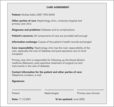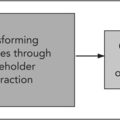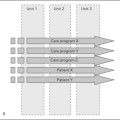Chapter 5. Putting the patient in the middle: managing chronic illness across organisational boundaries
Hannele Kerosuo
Introduction
Boundaries hamper patient care especially for patients suffering from multiple and chronic illnesses because their care is characterised by a multiplicity of intertwining health problems and needs that themselves are increasing in complexity and in turn cause difficulties for effective service provision (Davis et al 2000, Plsek & Greenhalgh 2001, Wagner & Groves 2002, Wilson & Holt 2001). Further complexity is added as medical and drug technology and treatment advances not only for acute conditions but also for chronic diseases (Wagner & Groves 2002). Patients with chronic disease are generally simultaneously in the care of several specialists who are often geographically separated in numerous clinics providing different levels of care. In any one episode, this can lead to no one taking overall responsibility for coordinating the patient’s care, and hence patients are left ‘in the middle’, ‘in no-man’s land of care’ where care needs are not necessarily attended to as they should be (Kerosuo 2006:2).
Managing the boundaries in chronic illness is an urgent task. As advanced medical technology, pharmacology and treatment help people live longer, they require care for longer periods of time. How, then, can we improve the organisation of healthcare that requires clinicians with different clinical and professional orientations to collaborate, particularly where care relationships are characterised by individual clinicians delivering episodic care to individual patients? This chapter considers the impact of organisational, professional and practice boundaries on patient care, specifically the care of patients with multiple and chronic illnesses. Ameliorating the effect of boundaries means reinterpreting the outcomes of care, the role of the patient and the responsibility of treating clinicians that in turn mean creating new ways to conceptualise and deliver care within the context of organisation and organisations.
As with many of the health systems represented in this book, the Finnish healthcare system is segmented into primary, secondary and tertiary care sectors provided by different levels of government: primary and general hospital care by local municipal authorities; secondary and tertiary care by hospital districts and regions. Healthcare is further segmented by clinical specialties that have created their own clinical communities and their own specialty-specific care practices. Thus, patient referrals within and between clinical specialties and patient pathways within and between the different levels of care presage changes not only in the patterns of care, but also in clinical practice, clinician collaboration and organisational integration. In this chapter, we consider the organisation of patient care having regard to:
▪ patient trajectories of care
▪ the boundaries within care trajectories
▪ the use of collaborative tools to span the boundaries.
Patients’ care trajectories as a developmental challenge within the intervention
We use the concept of a patient care trajectory to understand how illness is managed. The concept allows us to construct a comprehensive view of care for chronic illness within the context of inter-organisational care, that is, care that is carried out by a multiplicity of independent, specialist ‘organisations’, including for instance that provided by multispecialties and multidisciplines where comorbidities exist in the patient’s presentation. The concept encompasses the temporal progress of events in caring for a person with a chronic illness. Strauss et al (1984:8) caution that a patient’s care trajectory describes ‘not just the physical course of illness but all the work that patients, staff and kin do to deal with the illness, and all the social/psychological consequences that encircle the illness course (its intrusiveness on relationships, temperament and so forth)’. The multiple illnesses that accompany patient comorbidities can involve different levels of care and different types of work that bring complexity to the division of labour and raise confusion about the coordination of care (Strauss et al 1984). Trajectories help us ‘see’ the care as one connected episode, and alert us to the problems, disturbances, tensions, gaps and innovation efforts that can occur in daily practice as they act as drivers of development and changers in intervention (Engeström 1987:174).
These trajectories of care can be constructed from observation, interviews and video clips that describe the actual care setting as well as from parts of patients’ health documentation. We focus on data from a number of case histories to develop our approach to care trajectories. The data are drawn from an ethnographic study of organisational activity – actions and interactions in routine and developmental practice carried out in two phases in the specialties of internal medicine that included cardiology, endocrinology, pulmonary diseases, rheumatology and nephrology. Phase one involved mapping the problems and discussing them in intervention sessions organised by the researchers in inter-organisational care for 16 patients and their providers from two healthcare centres, five secondary care hospitals and three university hospital clinics in Finland. Phase two involved creating and testing new collaborative tools as solutions for inter-organisational care fragmentation and involved 10 patients and a pilot group of 13 doctors and three nurses (Engeström et al 2003, Kerosuo 2006). We present the data of a patient case as an example of a trajectory developed through the research is presented in Table 5.1.
| Patient | Patient 6: Male aged 54 |
| Observation | Field diary and videos of care settings |
| Interviews |
The patient (15.3.200X)
Internist, secondary care clinic (29.3.200X)
Cardiologist, university hospital (4.4.200X)
General practitioner, primary care (5.4.200X)
Nurse, primary care (5.4.200X)
Nurse, secondary care clinic (6.4.200X)
Clinician, university hospital (11.4.200X)
Pulmonary specialist, university hospital (14.4.200X)
|
| Patien’s health documents |
Health centre (14 pages)
Secondary care hospital (9 pages)
University hospital (32 pages)
|
| Laboratory session | Held 19.4.200X |
| Follow-up interviews | The patient (16.8.200X, 28.3.200X) |
The care trajectory for Hugo depicted above illustrates the inter-organisational care for the multiple chronic illnesses that Hugo suffers, namely hypertension, high cholesterol, diabetes, degenerative arthritis and eye trouble (cataract). He is overweight and not able to move well because of arthritis. Hugo’s illness and care trajectory can be described figuratively, as in Figure 5.1.
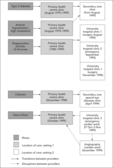 |
| Figure 5.1 |
In Hugo’s case, Figure 5.1 shows there were five care trajectories contained in one primary care clinic, one secondary care clinic and three university hospital clinics. The care of hypertension, high cholesterol and diabetes occurred together. Transitions from one provider to another are depicted with arrows. The broken arrows depict disruptions between the providers representing the different levels of care.
The problems emerging in Hugo’s care relate to communication disjunctions between the different providers. The first disjunction in communication occurred when clinicians at the health centre clinic transferred Hugo’s care for diabetes to the secondary care hospital. They expected the secondary care clinic to take care of the hypertension, elevated cholesterol and tests for blood consistency. The patient also expected that. However, the tests for blood consistency were not done at this clinic, and the patient did not know that it was important to have the tests for blood consistency done at least once a month.
The second and third disruption in the flow of information related to communication between the university hospital and the primary health centre clinic. The care document concerning the angiography for heart disease from the university hospital clinic to the primary health centre clinic did not reach the other end. Therefore, the primary health centre clinician lacked the information from cardiology about the follow-up for heart failure to be conducted at the primary health centre. The patient thought that the cardiology clinic did the follow-ups; he was wondering why it was taking so long for the cardiology clinic to give him an appointment, especially because he was afraid that he was going to have another infarct before receiving treatment.
The patient’s experience was that his overall care was not conducted as it should be. He was expecting to be operated on for his heart and his knees. He was having the same laboratory tests run in two different places and the providers kept changing his care. The professionals were quite surprised by the disjunctions in the patient’s overall care but thought they were not the only ones to blame for the disjunctions – the patient himself was also passive in his care. A possible ‘solution’ was for the providers to negotiate to eliminate the disjunctions in Hugo’s case. The patient himself was present during the first negotiation arranged by the researchers but not the second negotiation, conducted by the primary health centre providers and a specialist from the university hospital clinic.
The general opinion was that Hugo’s overall pattern of care was not run properly. The cardiology specialist commented that there were too many providers involved at the second negotiation: seven specialists treated the patient during the last episode at the cardiology clinic (in 1999), and two primary health centre clinicians and two secondary care clinicians treated the patient in primary and secondary care. The providers could not negotiate a solution to secure the overall care. One barrier related to the providers’ opinion that the patient had become non-compliant when in fact he did not know how the healthcare system worked. Beginning to solve the pattern of Hugo’s care involves drawing a map of the overall view of care, as in Figure 5.2. The locations of care are marked in boxes; one box represents one location of care. The connections between locations are depicted with double-headed arrows representing the long-term care relationships and single-headed arrows representing a single visit.
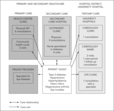 |
| Figure 5.2 |
Hugo’s case shows that many boundaries crosscut the care of patients with multiple and chronic illnesses. Two types of organisational boundaries emerge: one is the organisational division between the levels of primary, secondary and tertiary healthcare, the other, clinical boundaries inside each level of organisation. The consequences of these boundaries for Hugo’s care were disruptions and gaps in the flow of information and the lack of an agent with an overall responsibility for care provision. How, then, do patients experience the effects of boundary divisions?
Pause for reflection
Who should have overall responsibility for patient care, when it involves multi-specialties and multi-professionals, as well as the patient and their family members?
The effects of boundaries
Boundaries between levels of care emerge as disruptions, gaps and overlaps (Kerosuo 2007). In one instance, data relating to the experience of an elderly woman show that primary and tertiary professionals treated her ailments without each other’s knowledge. These data are drawn from the ethnographic research described earlier in the chapter. The patient suffered from asthma, circulatory disorders, infection of the urinary tract and osteoporosis. She had mainly been treated at the pulmonary clinic at the university hospital and at the health centre clinic. She was uncertain about the treatment for urinary tract infection since the care she received from the primary and tertiary clinicians varied. Not surprisingly, she felt that she was not treated properly. Her account of her care follows.
Patient: If I go to [the pulmonary clinic] specialised care there is a different doctor every time who prescribes a different medicine. Then I visit the doctor [at the health centre clinic] and she says that you cannot take that medicine [for your urinary tract infection] now. And I am confused because I do not know whom to believe and what to believe and what is wrong with me … They have not fixed [my condition], no one has fixed it; no one has cared for me.
(10 December 2001)
The unconnected nature of inter-organisational practice emerges as it becomes evident that professionals believe that ‘others’ are taking the responsibility for care. A further patient with coronary artery disease, diabetes, COPD, swelling and pulmonary symptoms had been a patient at the health centre clinic for seven years and also visited the university hospital in emergency situations. The disruption and gaps between the levels of care affecting the patient emerged in meetings between the university hospital physician, the health centre physician and the home care nurse as the professionals became aware that nobody was looking after the patient’s diabetes and lipids. The health centre physician thought that the university hospital was in charge of care and vice versa.
A further example shows that not only is clinical care uncoordinated, so too is the organisation of tests. In the next instance, a relative reports on her mother-in-law’s experiences. Her mother-in-law, an elderly woman with memory problems who needed the help of her relatives, required treatment for a fracture of the thigh, pleura in the lungs and convulsions, for which she received care at three hospitals in short intervals. The discoordination of care concerned laboratory tests – the same laboratory tests were run in the health centre clinic, the health centre hospital and the university hospital on successive days.
Patient’s relative: She is not able to walk very well, and therefore I tried to ask whether the tests taken over there [at the health centre clinic] are enough. [The tests] were taken the day before. Or was it after? But in any case they said that they take their own tests over there [at the health centre clinic], and we take our tests here.
Patient’s physician: This is unfortunately true. Our laboratories do not communicate with each other; they have different computer systems.
(15 February 2001)
Disruptions in the flow of information between levels of care are an example of problems in healthcare that are difficult to solve. Some relevant information, for instance medication or changes in care, may not be transferred between providers. The primary care physician often lacks relevant information from other locations of care. In one case, for instance, a primary care physician provided care for a patient with severe heart failure. She did not, however, know about the heart failure because she had not received any information about it from the university hospital where the patient was treated. The patient for his part thought that the information was shared because he had signed a form giving permission for this to occur.
In other cases, patients sometimes act as postmen, carrying documents between clinicians in the different levels of care. Some patients collected their own personal files that they used when they felt that information was not flowing properly. One patient, worried about the professionals’ lack of acquaintance with the information concerning his illnesses, actually took charge of delivering information to the health centre hospital. Because he was uncertain that the hospital had all the relevant information about his renal treatments, he asked his wife to bring all his medical documents from home. He then asked the physician at the ward, and later the senior physician, to read through the documents in order to prescribe the proper medication for his current ailments.
Patient: [The senior physician] said that he would get acquainted with [my medical documents]. I said no, I will give them to you now and you will see what is in there, and we will then see what the diagnosis from these [symptoms] is … The senior physician sat down and read and said that it is quite clear now. Here we have plain orders what we should take, what medication we should use. And the physician at the ward agreed. And that was the end of the [ailments].
(3 May 2000)
Boundaries between specialties
Occupational groups and professions establish communities to sustain their interests, privileges, specialised training and their occupational identity (Freidson 1970). These communities are internally divided by further sub-specialties and stratification (Freidson 1988). Besides the division between generalist and specialist medical practice, the profession of medicine has evolved into diversified specialties and sub-specialties. This specialisation manifests as numerous clinics that provide specialised services, for example at the university hospital. Ideally, the collaboration between specialties is perceived as seamless, and specialists commonly refer to the exchange of information through the shared documentation in the hospital clinics. In practice, however, collaboration between the specialties is difficult, as the following discussion between an endocrinologist and patient illustrates.
Endocrinologist: This pattern between primary and secondary care, although it limps, it is still easier than … the internal exchange of information at the university hospital … Although, it is perhaps difficult for a layman to understand … Why does one not [have all the information available regarding a patient] when it is [in] the same building? … We are unbelievably far away [from each other], sometimes it feels like a light year away.
Patient: It is because some are on the eleventh floor, and the others are on the ground floor.
Endocrinologist: Yes, and those are, in practice, very … specialised divisions …
(20 June 2001)
For a patient, the overlaps in healthcare services sometimes seem odd. One patient, who suffers from diabetes and associated diseases including ailments with his lower limbs, and treated by a surgical specialist and endocrinologist in parallel, reports an incident about the use of surgical stockings as an example of inter-specialty collaboration difficulties.
Patient: I could tell … how I felt from my point of view. Over there at the outpatient clinic for treating legs [poly-neuropathy] they had the opinion that I needed a surgical stocking for the blood circulation in the leg … I had reservations about it … but then I went to a store [that] specialised in health products and ordered the stocking. But then I had a visit with the surgical outpatient clinic the next day, and I went there. And I happen[ed] to mention this stocking. Then the surgeon said … cancel it immediately. So, this is how I got contradictory information. You see, a patient gets a little lost when he does not know. There are two [opinions]; these are specialists – educated specialists in medicine – who take opposite views.
(20 June 2001)
Here, the differences between the specialty content and actual clinical practice created boundaries, often associated with the temporality of contact between the different specialists. Cardiac patients, for instance, are often treated for a short period at a hospital cardiology department, while in the rheumatology clinic, specialists have long-term relationships with their patients. Because of this difference, the opportunities that these specialties have to collaborate are specific. The cardiologists have limited opportunities for inter-organisational collaboration concerning individual patients, while rheumatologists can collaborate on a longer term basis.
Further, as demands for cost-effective care increase, there is a flow-on effect on the practices of clinical specialties. Through cost shifting, different specialties transfer costly treatments to other specialties to minimise their own costs. If an orthopaedist finds out that a patient treated in rheumatology needs an instrumental aid in his or her care, they do not order that aid due to the costs but refer the requirement for the aid to the rheumatology clinic. Clearly, while this may advantage the budgets of individual clinical departments, it does not help individual patients. Changing the focus of care, then, from the interests of the provider to those of the patient will require a range of solutions, including changes in attitudes clinicians have to the way they treat patients, the centrality of patients’ interests when plans of care are being made and treatment is being delivered, and importantly, in the ways that clinicians relate to each other, to achieve the goals of care for patients whose care they share.
Pause for reflection
Who should take responsibility to eliminate the disruptions to care that can arise from administrative arrangements, such as budgets and performance outcomes?
Spanning boundaries – creating new tools for collaboration
Providers who represent single specialties tend to focus on single ailments or symptoms and risk losing sight of the overall picture of care (Kerosuo 2003). By encountering providers who represent other levels of care, an experience of collective learning is automatically created. While prevailing boundaries are challenged and defended, simply by encountering others, new rules are created for information exchange and new divisions of care responsibility between providers are negotiated. In the case of Hugo, when challenged, providers agreed to organise a negotiation session to improve problematic aspects of care. Patients also become learners as ‘Mark’ reflected on his experiences.
Patient: Suddenly I realised … that I would have to go around like an orphan [to receive care]. I think that it was the attitude of the senior specialist that was really important there. That he considered and was prepared to take overall responsibility for my care in the clinic.
(5 March 2001)
For Mark, it became clear that his overall care was organised by a system of care providers and that it was in danger of becoming disrupted. He learnt that the division of care responsibility could be negotiated with the providers across organisational boundaries. Providers also learn as they come together to create and test new collaborative tools. A package consisting of a care calendar, a care map and a care agreement become the core tools through which clinicians can reorient and re-order their patient care processes across their organisational and professional boundaries. Central to the re-ordering is the coming together of the different clinicians from their different levels of care to discuss specific patients, not just as clinicians, but as members of a team that also includes the patient and representatives from the diverse healthcare organisations that provide care to the patient.
Learning is an elemental part of creating and implementing new tools. As Béguin & Rabardel note (2000:175)‘an artifact only becomes an instrument through the subject’s activity’. The new care calendar, care map and care agreement are templates to be modified as the context and situation dictates. Taking the case of Hugo from Figure 5.1 and in listing the history of Hugo’s diseases, his descriptions of his symptoms and illnesses and his diagnosed illnesses and their treatments reported in the patient’s health documents, the care calendar acts as a template within which to contain and sequence complex, dislocated, shared information. The care map template depicts prevalent care relationships, the information exchange between the providers and the division of care responsibility. The care agreement epitomises the joint negotiations between patient and provider, including knowledge about the patient’s illnesses and symptoms and their concerns about those illnesses. Through the care agreement, patients are no longer passive receivers of expertise, but become experts themselves in their own care, or perhaps, rather, are given the opportunity to contribute the expertise that they have always had (Engeström et al 2003).
Professionals enrich the tools as they use them (Kerosuo & Engeström 2003). Through use, clinicians communicate between each other and thereby create new meaning as they engage in new sense-making activities. An example is the doctor who began sketching an illness model of a client at the community health centre as an amoeba – the several ‘legs’ of the amoeba marked the various illnesses of the patient in the model. Yet another clinician brought new insights to the care calendar as depicted in Figure 5.3, by using it not only as a means of describing the patient’s care provision to others, but also as a tool for managing the patient’s present care. We use this clinician’s example to illustrate the use of a care calendar to reconfigure a patient’s care trajectory.
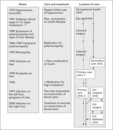 |
| Figure 5.3 |
Developing new collaborative tools is complex (Kerosuo & Engeström 2003). It requires a long process of experimentation and their use is often resisted. But in taking Nicklas’s case (see Figure 5.4), we show how a turning point is created. As one specialist began using the care agreement template as a part of her regular clinical work to ensure Nicklas’s overall care, she and Nicklas completed the form together during his regular visit to specialised care. Then, using the form, she telephoned the primary care clinician after the visit and told the clinician about the care provided at the specialised clinic. Using the form, she ensured that the clinician was aware of the care expected to be carried out in the primary care clinic. Finally, she posted the care agreement form to the primary care clinician.
These new tools not only enabled organisational boundaries to be crossed, they encouraged, necessitated even, new forms of practice. By compiling information comprehensively and sequentially in one location, clinicians see new patterns that allow them to reflect on and alter their own practices. Disruptions, disjunctions and problems, once hidden within the logic and fragmentation of single, episodic disease-specific management, are illuminated and resolved as the multiplicities of complex comorbid conditions are exposed, information exchanged, care agreed and division of responsibilities negotiated. This care negotiation emerged as a new clinical practice with defined phases: choosing a patient; using the care calendar and care map to compile and view overall care; ensuring appropriate functioning of care provision; attending to care gaps; agreeing care; and updating the care agreement (Kerosuo & Engeström 2003).
Conclusion
Organisational, professional and practice boundaries cannot be crossed easily. Organisationally based sets of cultural rules and resources bind the behaviour of healthcare providers into separated units of actions. Creating critical pathways of care has improved the inter-organisational care for single diseases but our findings demonstrate that the overall care for patients with multiple and chronic disease is crosscut by boundaries affecting the overall process of care. Patients experience boundaries as bringing uncertainty and unreliability to their care and turn the patients into bystanders.
Creating new collaborative tools is essential to ensure the overall chronic illness care within the inter-organisational context. The electronic patient record system is improving information exchange between levels of care but its effects on collaboration and communication are still missing. Implementation and spread of clinical innovations such as the one presented in this study is problematic in the healthcare sector generally. For instance, Buchanan et al (2007) report the difficulties of implementing clinical innovations in the UK. According to their findings, the spread of innovations is influenced by the interplay of multiple and complex contextual, substantial, and process factors in innovations (Buchanan et al 2007). Diffusions of healthcare innovations do not proceed smoothly but are inhibited by inter- and intra-professional boundaries between professionals and expert groups (Fitzgerald et al 2002). These kinds of discontinuities can be mended by ‘bridging actions’ (Engeström et al 2007). Managerial decisions creating new organisational structures and spaces for inter-organisational collaboration, establishing new projects that enrich the outcomes of previous ones and launching personnel training are examples of such bridging actions.
Patient participation is important. While reports of patients’ experiences of illnesses have a long history in medical sociology, only a few deal directly with patients’ experiences of healthcare organisations (Frankel & Treger Hourigan 2004). Since patients have knowledge about the overall health services that professionals often lack, their views and experiences are a valuable resource for managing chronic illness across organisational boundaries.
Box 5.1
Interweaving the fragmented care for chronic patients can be secured by creating new collaborative tools and related practices.
Tool creation represents a process of expansive learning during which participants reinvent their daily care practices.
Healthcare management needs to be alert to creating opportunities for expansive learning.
References
Béguin, P.; Rabardel, P., Designing for Instrument-Mediated Activity, Scandinavian Journal of Information Systems 12 (2000) 173–190.
Buchanan, D.A.; Fitzgerald, L.; Ketley, D., The Sustainability and Spread of Organisational Change. (2007) Routledge, London and New York.
Davis, R.M.; Wagner, E.G.; Groves, T., Advances in managing chronic illness, British Medical Journal 320 (2000) 525–526.
Engeström, Y., Learning by Expanding: An Activity-theoretical Approach to Developmental Research. (1987) Orienta-konsultit, Helsinki.
Engeström, Y.; Engeström, R.; Kerosuo, H., Discursive construction of collaborative care, Applied Linguistics 24 (2003) 286–315.
Engeström, Y.; Kerosuo, H.; Kajamaa, A., Beyond discontinuity: Expansive organisational learning remembered, Management and Learning 38 (2007) 319–336.
Fitzgerald, L.; Ferlie, E.; Wood, M.; et al., Interlocking interactions: the diffusion of innovations in healthcare, Human Relations 55 (12) (2002) 1429–1449.
Frankel, R.M.; Treger Hourigan, N., Thirty-five voices in search of an author: What focus groups reveal about patients’ experiences of managed care settings, Communication & Medicine 1 (2004) 44–58.
Freidson, E., Professional Dominance: The Social Structure of Medical Care. (1970) Atherton Press, New York.
Freidson, E., Profession of Medicine. A Study of the Sociology of Applied Knowledge. (1988) University of Chicago Press, Chicago.
Kerosuo, H., Boundaries in health care discussions: an activity theoretical approach to the analysis of boundaries, In: (Editors: Paulsen, N.; Hernes, T.) Managing Boundaries in Organisations: Multiple Perspectives (2003) Palgrave Macmillan, Basingstoke.
Kerosuo, H., Boundaries in Action: An Activity-theoretical Study of Boundaries in Health Care for Patients with Multiple and Chronic Illnesses. (2006) Helsinki University Press, Helsinki;http://ethesis.helsinki.fi/julkaisut/kay/kasva/vk/kerosuo/boundari.pdf.
Kerosuo, H., Renegotiating disjunctions in interorganisationally provided care, In: (Editor: Iedema, R.) The Discourse of Hospital Communication: Tracing Complexities in Contemporary Health Care Organisation (2007) Palgrave Macmillan, Basingstoke, Hampshire, UK and New York.
Kerosuo, H.; Engeström, Y., Boundary crossing and learning in creation of new work practice, Journal of Workplace Learning 15 (2003) 345–351.
Lindberg, K.; Czarniawska, B., Knotting the action net, or organising between organisations, Scandinavian Journal of Management 22 (2006) 292–306.
Plsek, P.E.; Greenhalgh, T., The challenge of complexity in health care, British Medical Journal 323 (2001) 625–628.
Strauss, A.L.; Fagerhaugh, S.; Suczek, B.; et al., Social Organisation of Medical Work. (1984) Transaction Publishers, New Brunswick and London.
Wagner, E.H.; Groves, T., Care for chronic diseases: The efficacy of coordinated and patient centreed care is established, but now is the time to test its effectiveness, British Medical Journal 325 (2002) 913–914.
Wilson, T.; Holt, T., Complexity and clinical science, British Medical Journal 323 (2001) 685–688.

